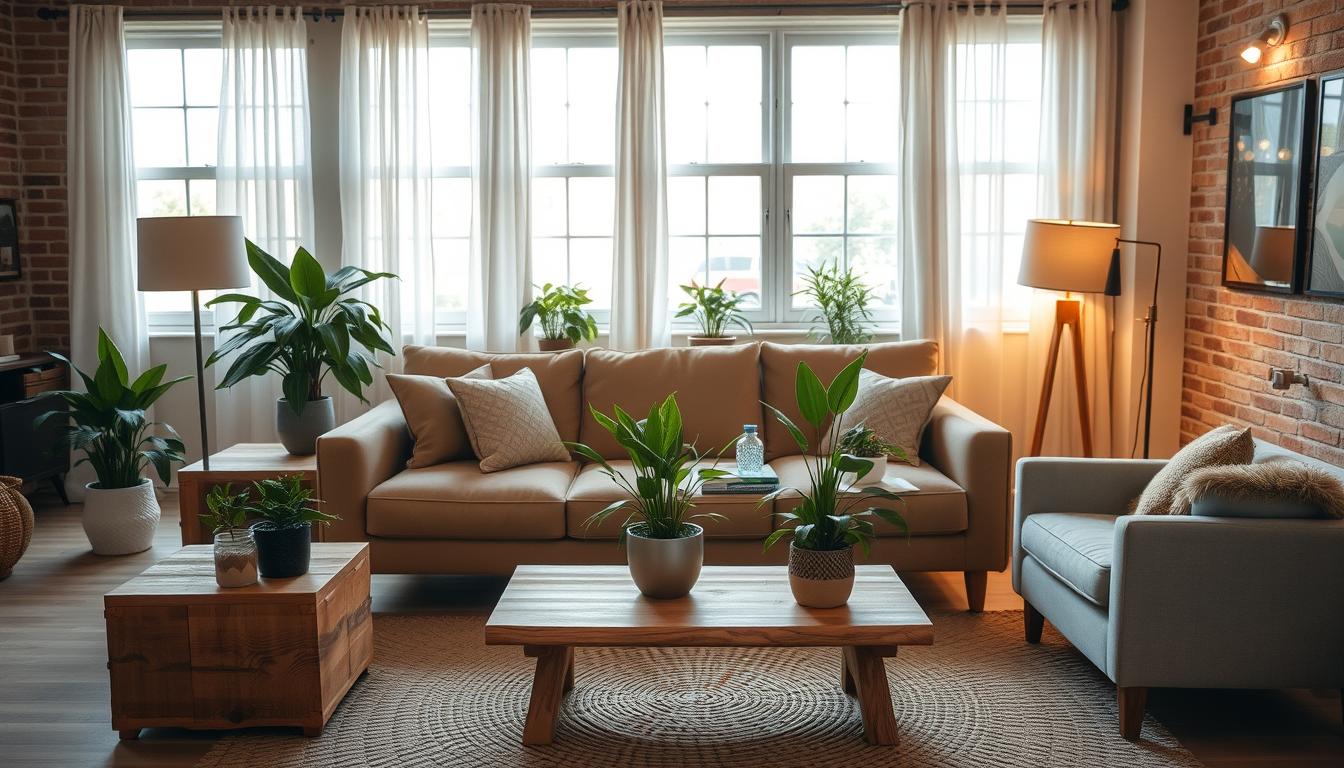In today’s world, it’s vital to focus on sensory wellness. Using natural surfaces in our homes and offices boosts health. These environments support our mental and physical well-being.
Wellness design looks at how spaces impact our feelings and health. It highlights the value of touching materials like wood, stone, and fabrics. Natural surfaces add beauty and are key for our sensory wellness. They help create spaces that relax and inspire us.
The Importance of Sensory Wellness in Design
Design plays a big role in how we feel and stay well. Understanding how our surroundings affect our mental health shows us why sensory wellness matters in design. Spaces that are made for well-being are both useful and beautiful. They help us feel emotionally strong.
Good design considers how environments affect our minds. It uses colors, layouts, and materials to make us feel a certain way. When design is done right, it makes places welcoming. This can lower stress and make life better.
Things like textures, sounds, and lights change how we feel in a space. They do more than make us comfortable; they improve our overall happiness. Design is not just about how things look. It’s about connecting with our surroundings. This shows why sensory wellness is key to making spaces that heal and work well.

Understanding Natural Surfaces
Natural surfaces are very important in interior design. They add beauty and function with materials like wood, stone, and fibers. These surfaces make a room feel more inviting by adding warmth and texture.
Choosing natural materials can also help the environment. For example, using sustainable wood helps reduce carbon footprints. Stone is lasting and doesn’t need harmful chemicals. These eco-friendly choices make spaces healthier.
Adding textures like these makes a space feel cozy and welcoming. The right materials can make a house feel more like a home. Using natural elements means creating beautiful, sustainable living areas.
Sensory Wellness through Natural Surfaces
Adding natural surfaces into design helps our senses and emotions. These materials make places look better and feel closer to nature. This has good effects on our emotional well-being and clarity of mind. Touching and seeing natural textures makes spaces more comforting and peaceful.
Connection to Nature and Well-being
Using natural surfaces in environments helps people feel connected to their surroundings. This connection has big benefits for our minds. Studies show that being close to nature reduces stress and boosts emotional health. Adding natural elements like stone or wood brings peace. This is key for clear thinking, especially for those escaping city life.
Benefits of Natural Textures
Natural textures are great for design because they engage our sense of touch. Materials like coarse stones, rough textiles, or smooth woods add to comfort. They appeal to our eyes and meet emotional needs, making us feel grounded. Unlike synthetic materials, natural textures offer warmth and realness. They help create spaces that promote well-being and enrich our lives.
Incorporating Natural Light for Wellness
Getting more natural light into our homes is key to making them look and feel better. Correctly placing windows is important for spreading light around. Well-placed windows make rooms welcoming and have health perks like lifting your mood and helping you sleep right by keeping your body’s clock set. Designing with natural light in mind can make a big difference in how we feel and work, turning ordinary spaces into calming retreats.
Maximizing Window Placement
Choosing where to put windows is crucial for enjoying natural light. Here are some ideas:
- Orient windows to face south or southwest for optimal sunlight exposure.
- Use large windows or glass doors to create expansive views and enhance light flow.
- Incorporate skylights, particularly in areas where wall space is limited.
- Strategically position windows to reduce glare while maximizing brightness.
Using Reflective Surfaces
Adding reflective surfaces helps spread natural light more in a space. Adding mirrors and shiny finishes can make a room brighter. For the best effect, here are some suggestions:
- Position mirrors across from windows to bounce light throughout the room.
- Select furniture and decor with glossy or light-colored finishes to increase light reflection.
- Utilize light-colored walls and ceilings to create a brighter overall appearance.
Choosing Sustainable Materials for Your Space
Choosing eco-friendly materials is key to a green design that helps our environment. In designing a space, we must think about both how it looks and how sustainable it is. Picking materials from your local area can cut down on harmful effects from moving goods and helps the local community too.
Using Local Resources
Choosing local materials is good for the planet. Using things like old wood and stone from nearby helps small economies and keeps pollution low. These materials also look great and support green practices.
The Impact of Low-VOC Materials
It’s important to pick materials that have low amounts of VOCs to keep the air clean. Products with high VOCs can make people sick and cause breathing problems. Low-VOC paints and furniture make indoors safer and support the environment. This helps in making living spaces healthier and more eco-friendly.
Integrating Natural Elements: The Role of Plants
Having indoor plants helps our well-being in many ways. They make our living spaces healthier and bring many health benefits. Plants in a room make it look better and help us feel calm and relaxed.
Benefits of Indoor Plants
Indoor plants offer more than just beauty. Key benefits include:
- Lowering stress by taking care of plants.
- Boosting mood and productivity.
- Improving thinking thanks to cleaner air and their calming effect.
Air Quality Improvement
Indoor plants are great for cleaning the air. Plants like the peace lily and snake plant remove bad toxins. This makes our living spaces healthier and improves our health. Interacting with these plants helps us feel connected to nature while they cleanse the air.
Designing Open and Fluid Spaces
Open spaces make us feel free by breaking free from old designs. People love how open floor plans bring in more sunlight and make it easier to hang out together. These spaces remove walls, making rooms feel cozy and good for our mental health.
The Impact of Open Floor Plans
Open floor plans blend rooms together, creating a lively vibe. They let people change the space to suit their needs. Because there are no walls, everyone finds it easier to chat and connect, making family and friend time better.
Creating a Sense of Flow
When we design open spaces, we think about making them easy to use. The right layout connects spaces while keeping them looking good together. This makes moving around and interacting with others smooth and easy.
Creating Zones for Mindfulness and Relaxation
Setting up special zones for mindfulness and relaxation boosts emotional health. These zones are perfect for meditation and relaxation. They aim to lower stress and bring back energy every day through thoughtful design.
Designating a Meditation Corner
Creating a peaceful meditation corner at home brings inner tranquility. You should consider:
- Comfortable seating, such as a floor cushion or a soft chair
- Soft lighting that creates a warm ambiance
- Minimal distractions to promote focus and relaxation
With careful design, meditation areas become perfect for deep practice.
Integrating Relaxation Nooks
Having cozy spots at home helps escape life’s busyness. Think about:
- Reading nooks with plush throw pillows and blankets
- Tranquil corners adorned with calming plants and artwork
Relaxation nooks are not just places to relax; they help improve emotional well-being. They motivate everyone to prioritize self-care and mindfulness.
Promoting Comfort with Ergonomic Design
Buying ergonomic furniture boosts comfort and well-being at home or work. It makes sure items like desks and chairs support a healthy posture. This reduces strain if you use them for a long time. When choosing furniture, it’s important to pick pieces that support you right and can be adjusted. This helps reduce back pain and increases how much you can get done.
Investing in Ergonomic Furniture
To really get the benefits of ergonomic design, add high-quality ergonomic furniture to your space. Look for:
- Adjustable chairs that provide lumbar support.
- Desks at the right height to maintain a comfortable posture.
- Footrests that promote proper alignment of the body.
Picking this type of furniture not only makes you more comfortable. It also helps you form healthier habits every day. This means you can do things more easily and efficiently.
Designing for Comfort in Every Room
Thinking carefully about design can make every room more comfortable. Spend on soft things and layouts that make relaxing easy. Consider:
- Choosing textiles that feel pleasant against the skin.
- Incorporating ample natural light for an inviting atmosphere.
- Arranging furniture to promote conversation and connection.
Focus on comfort in your design to keep spaces useful and welcoming for you and your guests.
The Power of Sound in Your Living Space
Sound shapes the atmosphere of our living spaces. It can make a space a sanctuary for unwinding. By managing sound well, we enhance our well-being and create peaceful places.
Using Acoustic Treatments
Acoustic treatments improve home acoustics. They help by reducing noise and boosting comfort. Using things like carpets and panels, we cut down on noise. This makes our homes more tranquil and helps us relax.
Incorporating Nature Sounds for Relaxation
Adding nature sounds to our spaces helps us relax. Sounds like water or birdsong make our environments serene. They reduce stress and add beauty to our spaces, making them calm and clear.
Seasonal Engagement with Nature
Being active in nature all year has many health perks. Design for each season leads us to enjoy the outdoors more. We get physical and mental benefits.
Every season has different activities that help our bodies and minds. These activities help us feel closely linked to where we live in diverse ways.
Year-Round Benefits of Outdoor Activities
Doing things outside all year improves health and happiness. The benefits include:
- Heart health gets better with activities like hiking and walking.
- Being in fresh air and sunlight makes our mood better.
- Seeing nature’s beauty in all its forms helps clear our minds.
Finding Beauty in Every Season
Every season lets us see nature in new ways. Loving all the seasons gives us deep joy. Think about doing these things:
- Spring brings flowers and nice weather for hanging out outside.
- Summer offers beach days and hikes at sunset for relaxation.
- Autumn shows off changing leaves, great for outdoor fun.
- Winter is for snow sports and cozying up around fires.
Enhancing Air Quality and Ventilation
Keeping the air in your home clean is key to staying healthy. Good ventilation helps improve indoor air. Adding natural ventilation is an easy way to make your home’s air better.
Natural Ventilation Techniques
Using natural ways to move air around your home can make a big difference. You can try a few methods:
- Using windows that open to get air flowing.
- Putting in ceiling fans to help control the air and temperature.
- Placing vents smartly to move air throughout your place.
Using Air Purifiers Effectively
Air purifiers work well with natural air methods to clean your air even more. To get the most out of them, remember:
- Choose air purifiers with HEPA filters to catch allergens and pollutants.
- Keep air purifiers on all the time for constant clean air.
- Change filters regularly to keep them working well.
Developing a Biophilic Design Approach
Biophilic design helps people feel close to nature through smart design choices. It mixes nature into our buildings and spaces, making us happier and healthier. When designers use nature in their work, they make spaces that are not just beautiful. They also boost our well-being.
Benefits of Biophilic Design Principles
Adding biophilic elements to spaces has lots of perks. For one, it makes our emotions better by linking us to nature. It also lowers stress, creating a calmer place to be.
Plus, it can improve our focus and get our creative juices flowing. Not to forget, it boosts our health with things like more natural light and fresh air. And of course, it makes spaces look great, which makes them more welcoming.
Creating Nature-Inspired Patterns
Designs inspired by nature can turn a space into something special. By using patterns from nature, we can make places look better and feel more peaceful. Here are some ways to do it:
- Use plant and landscape designs in fabrics and on walls.
- Bring in furniture and building details that have natural shapes.
- Pick colors that remind you of the outdoors, like browns and greens.
- Connect indoor spaces to the outside world with big windows and open areas.
Conclusion
Making our living spaces sensory-friendly is key in today’s world. By adding elements that connect us to nature and help our mental health, we make our daily lives better. This also boosts our overall well-being. Spaces thoughtfully made can deeply change how we live, making us more mindful and supported.
Looking ahead, using natural surfaces, lots of light, and green materials is important. These choices make our homes look great and feel even better. Like comfy living areas and cleaner air. Choosing sensory wellness is about more than looks. It’s about living in balance.
Let’s think about using these ideas in our own homes. By choosing designs that focus on making us feel good, we create healthier places to live. These places meet our body and mind’s needs.



